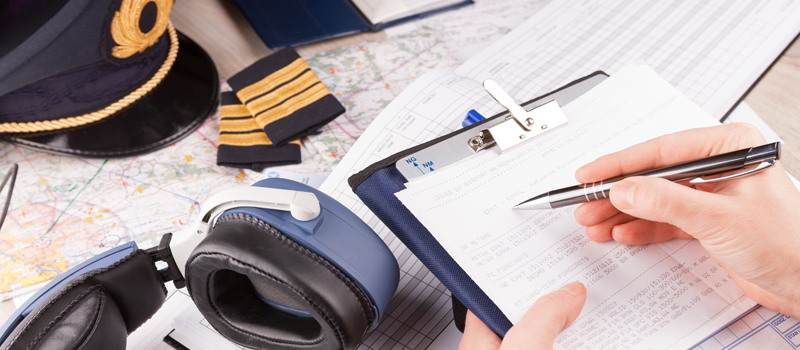-
Key Takeaways
-
BasicMed Overview
-
The Purpose of BasicMed
-
Who Is Eligible for BasicMed?
- Step 1: BasicMed Requirements
- Step 2: The Physical Exam
- Step 3: The BasicMed Course
-
BasicMed Restrictions
-
Interested in BasicMed? Start Here
- Step 1: See If You Qualify
- Step 2: Download the Checklist
- Step 3: See Your Doctor
- Step 4: Take the Online Course
- Step 5: Save Your Documents and Fly!
-
Conclusion
Traditionally, pilots needed a third-class medical certificate to take to the skies.
The introduction of BasicMed, a more flexible alternative, has changed the landscape for many pilots.
But what is BasicMed, and is it even relevant to you?
Let’s navigate through the clouds of confusion and explain everything you need to know about BasicMed.
Key Takeaways
- BasicMed allows eligible pilots to fly without holding a third-class FAA medical certificate.
- You must complete a physical exam with a state-licensed physician every 48 months.
- You must complete a free online BasicMed course every 24 months.
- BasicMed limits include flying below 18,000 feet, under 250 knots, with no more than six occupants.
BasicMed Overview
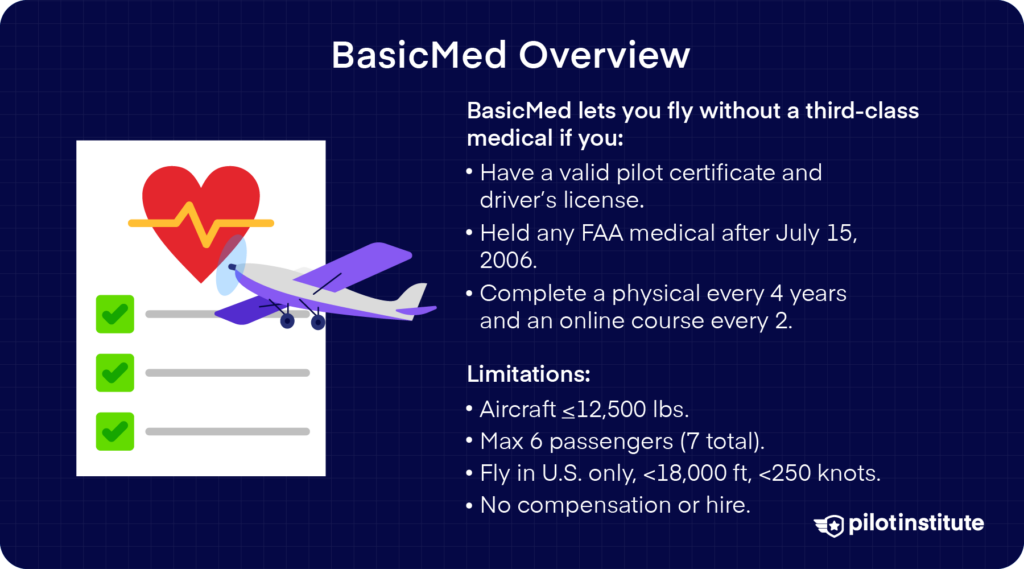
The purpose of BasicMed is to provide relief from the requirement to hold a third-class medical certificate.
If you meet the BasicMed requirements, you can fly according to BasicMed rules without an FAA medical certificate.
To qualify for BasicMed, you must:
- Hold a valid FAA Pilot Certificate.
- Hold a valid state-issued driver’s license.
- Have held any medical certificate on or after July 15, 2006.
To fly under BasicMed, you need to:
- Comply with BasicMed requirements.
- Undergo a physical exam.
- Complete an online BasicMed education course.
BasicMed allows you to exercise the privileges of a third-class medical, apart from the following limitations:
- The aircraft must have a maximum certified takeoff weight of no more than 12,500 lbs.
- The aircraft is not certified to carry more than seven occupants (six passengers).
- You may only fly in the U.S. below 18,000ft MSL at less than 250 knots.
- You may not fly for compensation or hire.
The Purpose of BasicMed
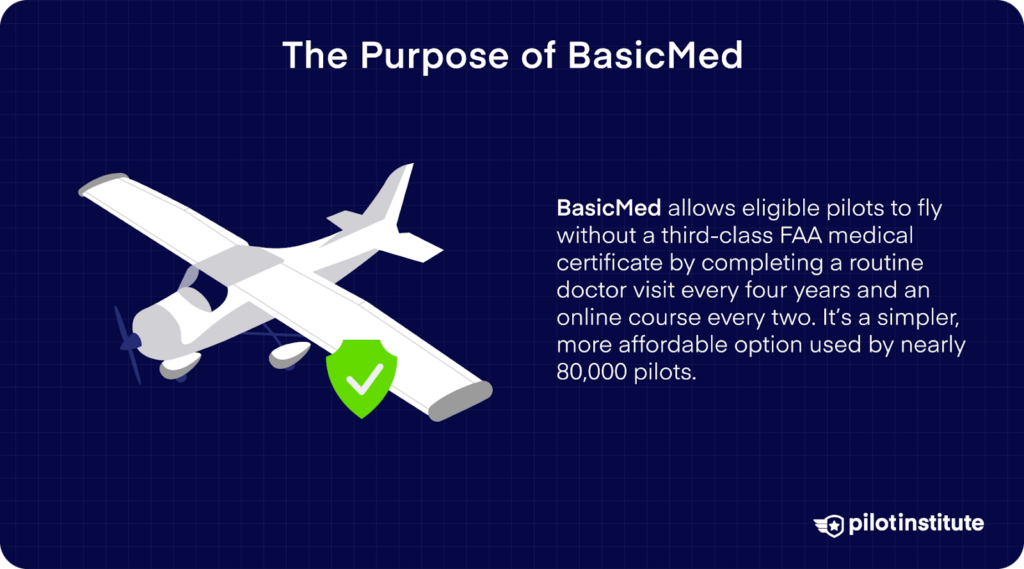
The purpose of BasicMed is to provide relief from the requirement to hold a third-class medical certificate.
In other words, instead of meeting the strict requirements for a third-class medical, you can fly under BasicMed rules instead.
For some pilots, the requirements of a third-class medical are unnecessarily restrictive. BasicMed has different restrictions tailored to these aviators.
If you meet the BasicMed requirements, you can fly according to BasicMed rules without an FAA medical certificate.
These rules make BasicMed a more convenient, efficient, and cost-effective way to obtain medical certification.
For example, pilots over 40 need to renew their third-class certificate with an FAA-approved doctor every two years. Under BasicMed, they can visit any doctor every four years and continue flying – a significant time and money saver.
Since its introduction in 2017, nearly 80,000 pilots have qualified for BasicMed.
Who Is Eligible for BasicMed?
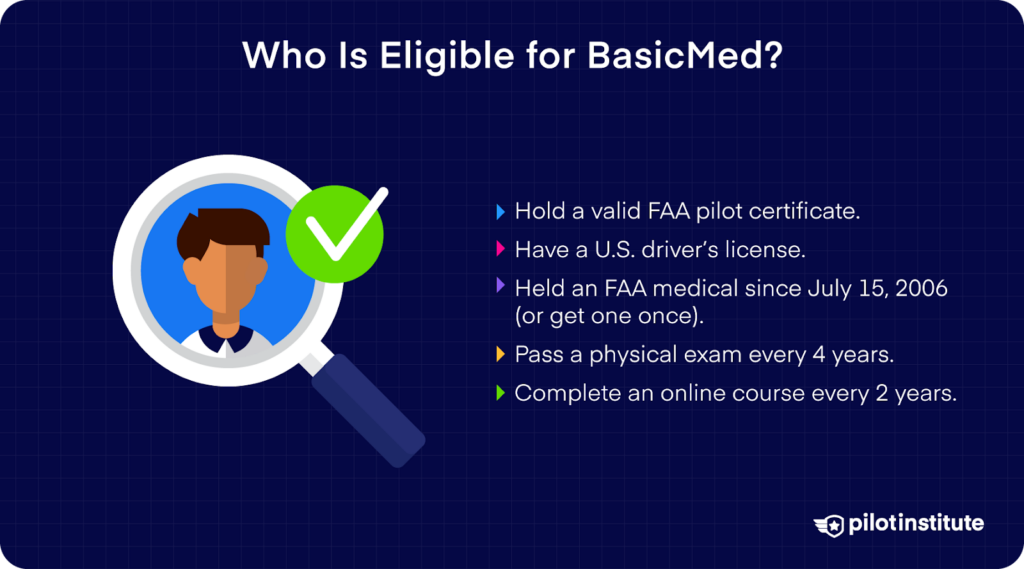
To fly under BasicMed, you need to:
- Comply with BasicMed requirements.
- Undergo a physical exam.
- Complete an online BasicMed education course.
Let’s explore these steps in detail before we dive into the BasicMed restrictions.
Step 1: BasicMed Requirements
To qualify for BasicMed, you must:
- Hold a valid FAA Pilot Certificate.
- Hold a valid state-issued driver’s license.
- Have held any medical certificate (1st, 2nd, 3rd, regular, or special issuance) on or after July 15, 2006.
If you’ve never obtained a medical certificate, you’ll need to obtain one (either regular or special issuance) one time only. After obtaining your medical certificate, you can fly under BasicMed and won’t need to renew your medical certificate.
The same applies if you had a medical certificate (regular or special issuance) that expired before July 15, 2006.
Step 2: The Physical Exam

Similar to the traditional FAA medical certificate, you’ll need to visit a doctor and undergo a physical exam.
There’s one big difference, however.
For BasicMed, you’re not limited to an FAA-approved Aviation Medical Examiner (AME). Any state-licensed physician can conduct your physical examination.
This allows you to see your primary care doctor, who might already know your medical history.
Before your visit, download the FAA’s Comprehensive Medical Examination Checklist (CMEC) from the FAA website.
This checklist contains two lists of questions that you and your doctor must answer. Ensure that you complete your questions before you undergo the exam.
During the exam, your doctor will review various health aspects, including vision, hearing, mental health, and general medical conditions.
If you have any cardiac, neurological, or mental health issues, you may need to obtain a special issuance medical (only once).
Once the examination is complete, your doctor will complete the Comprehensive Medical Examination Checklist.
After the physical, keep a copy of the completed checklist in your logbook (and save it in electronic format). You won’t need to send it to the FAA, but they may request to see it in the future.
You’ll need to visit a physician and complete the checklist every four years (48 months).
Step 3: The BasicMed Course

Finally, you need to take an online BasicMed education course.
There are two places you can take the course:
The BasicMed course takes roughly an hour to complete, and you’ll receive a certificate of completion afterward. It’s not particularly difficult, and you can retake the quiz as many times as you like.
The course is free – you just need to create an account to save your progress (also free).
You must retake the course every two years (24 months). Keep a copy of your completion certificate in your logbook and save it in electronic format.
BasicMed Restrictions
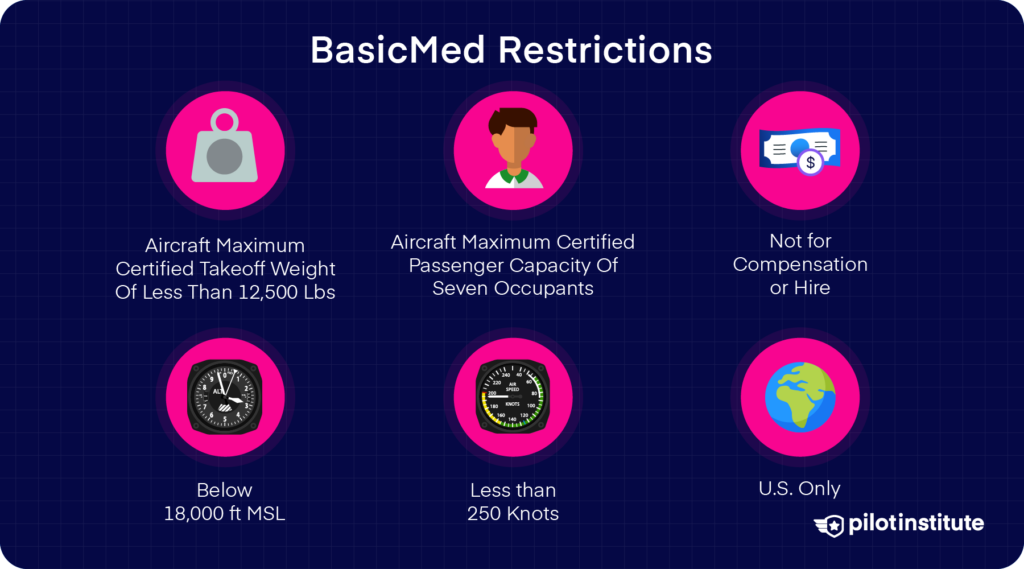
BasicMed has its own set of rules that you need to follow. Luckily, they aren’t unreasonable.
BasicMed allows you to exercise the privileges of a third-class medical, apart from the following limitations:
- The aircraft must have a maximum certified takeoff weight of no more than 12,500 lbs.
- The aircraft is not certified to carry more than seven occupants (six passengers).
- You may only fly in the U.S. below 18,000ft MSL at less than 250 knots.
- You may not fly for compensation or hire.
You can fly VFR or IFR under BasicMed, provided you and the aircraft are appropriately rated.
You may also act as a safety pilot for flights in simulated instrument conditions. This allowance is a new addition to BasicMed, implemented in December 2022.
While you cannot fly for compensation or hire, you may still split the pro-rata share of operating expenses when you fly.
Interested in BasicMed? Start Here
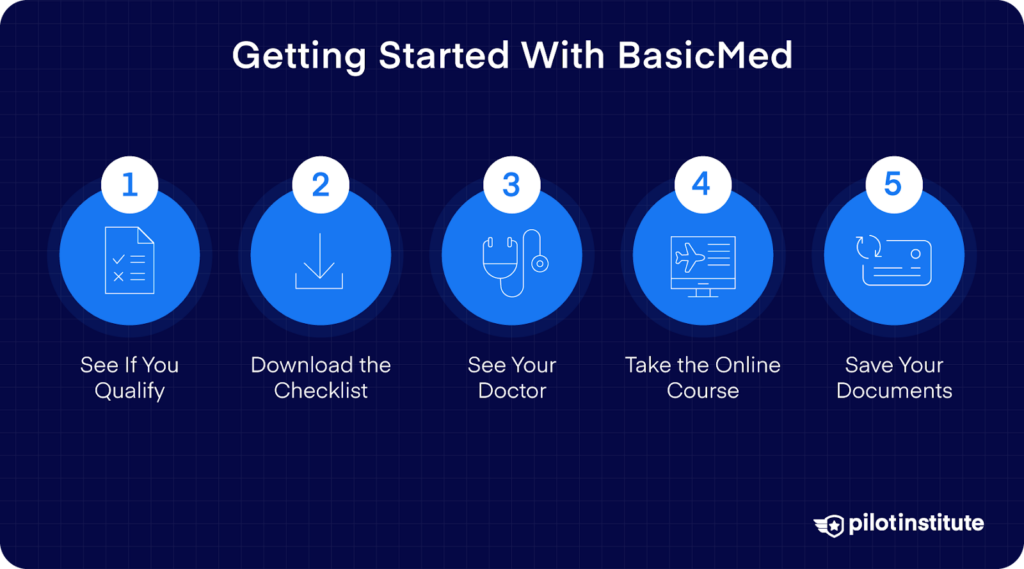
Step 1: See If You Qualify
The first step to flying under BasicMed is to go through an eligibility questionnaire to see if you qualify.
AOPA has a BasicMed questionnaire.
Step 2: Download the Checklist
If you are eligible, download the Comprehensive Medical Examination Checklist (CMEC) and complete your section.
Step 3: See Your Doctor
Schedule a visit with your doctor to complete the CMEC (the checklist).
Step 4: Take the Online Course
After your trip to the doctor, it’s time to pass the course from AOPA or Mayo Clinic.
Go onto either website, create an account, and take the course. After about an hour, you’ll receive your certificate of completion.
Step 5: Save Your Documents and Fly!
Congratulations! You can now fly under BasicMed!
Make sure you keep a copy of the completed CMEC (the checklist) and your certificate of completion from the course in your logbook. Remember to save them in electronic format, too.
Conclusion
While BasicMed provides an easier way to fly, it does not mean you are no longer responsible for ensuring you are fit to fly.
Keep healthy, see your doctor regularly, and ensure that there is no doubt in your capabilities as a pilot, regardless of what the law says. If you have further questions about BasicMed, this FAQ section from AOPA has you covered.



